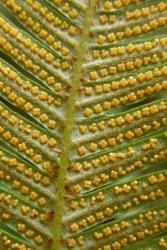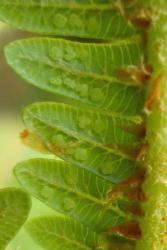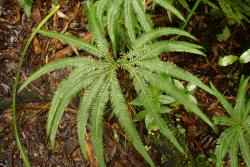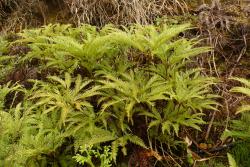Terrestrial ferns. Rhizomes long-creeping, scaly. Stipes scaly or glabrescent. Rachis with pinnate laminae (not NZ), or reduced to a bud at the apex of the stipe with a single pair of pinnae (NZ); rachis buds sometimes extending to produce another tier comprising a rachis terminating in another rachis bud and pair of pinnae (NZ). Pinnae unforked, being equivalent to an ultimate segment (not NZ) or to an ultimate leaflet (rarely NZ), or forking pseudodichotomously 1 to several times (NZ); buds at bifurcations sometimes extending 1-several times. Laminae, axes, and rachis and pinna buds bearing scales, sometimes hair-like. β costae bearing costal segments. α costae of the ultimate leaflets arising pseudodichotomously from distal end of β costae. Ultimate segments on α costa >4 mm long, oblong or linear, entire or crenulate, with once-branched veins between midvein and margin. Sori superficial, 3–18 either side of midvein, each with 3–5 sporangia. Spores monolete, rugulate and perforate.
A genus of about 95 species (Gonzales & Kessler 2011).
Allan (1961) included Sticherus in a broadly-circumscribed Gleichenia. The nomenclatural history of Sticherus was detailed by Pichi Sermolli (1972). The New Zealand species of Sticherus were reviewed by Brownsey et al. (2013).
| 1 | Proximal-most costae with 3–8 pairs of costal segments; ultimate segments arising at 70–85° from α costae | tener |
| Proximal-most costae usually with 0–2 pairs of costal segments (excluding pseudostipules), rarely 3–4; ultimate segments arising at 40–70° from α costae | 2 | |
| 2 | Scales on abaxial surface of α costae ovate, >250 µm wide; ultimate segments abaxially glaucous, 5–20 mm long | cunninghamii |
| Scales on abaxial surface of α costae acicular or hair-like, <200 µm wide; ultimate segments abaxially green, 8–55 mm long | 3 | |
| 3 | α costae >10 times longer than proximal-most costae; ultimate segments crenulate, crenulations extending along length of margin; angle between pairs of ultimate leaflets in centre of laminae usually 20–40°; confined to northern North Island | flabellatus |
| α costae usually <10 times longer than proximal-most costae; ultimate segments entire or crenulate, crenulations often restricted to apex; angle between pairs of ultimate leaflets in centre of laminae often 40–60°; confined to South Island | urceolatus |
Sticherus can be distinguished from the superficially-similar Dicranopteris by the presence of laminae on the axes subtending the pseudodichotomously-paired ultimate leaflets; that is, Sticherus has costal segments on the β costae, and Dicranopteris does not. In New Zealand, the ultimate segments of at least 5 mm in length distinguish Sticherus from Gleichenia, which has ultimate segments <3 mm long.
Widespread in tropical and southern temperate regions, although very few species in Africa; 54 species occur in the Neotropics (Gonzales & Kessler 2011), about 16 in Malesia (Holttum 1959) and nine in the tropical Pacific; in the southern temperate zone there are five species in both Chile (Marticorena & Rodríguez 1995) and Australia (Chinnock & Bell 1998). Four species in New Zealand; one endemic.
| Category | Number |
|---|---|
| Indigenous (Endemic) | 1 |
| Indigenous (Non-endemic) | 3 |
| Total | 4 |
The base chromosome number in Sticherus is x = 34 (Kramer 1990).







